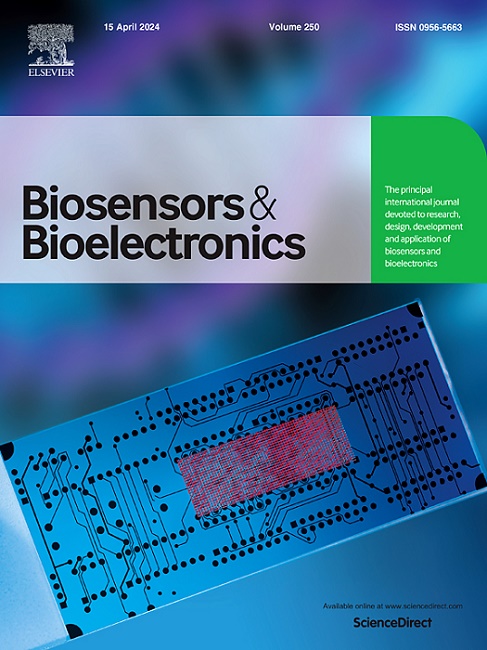单电极电化学发光免疫传感器用于水通道蛋白-4抗体的多重检测。
IF 10.5
1区 生物学
Q1 BIOPHYSICS
引用次数: 0
摘要
水通道蛋白-4 (AQP4)抗体的可靠检测对诊断视神经脊髓炎谱系障碍(NMOSD)至关重要。然而,基于细胞的检测是最可靠的方法,却受到设备不足的限制。本研究报道了使用银金属有机凝胶(Ag-MOGs)作为共反应剂,在基于单电极电化学系统(SEES)的电化学发光(ECL)免疫传感器中多重检测AQP4抗体。将Ag-MOGs修饰碳纳米管单电极,与AQP4肽孵育,最终实现AQP4抗体的固定化,构建免疫传感器。电极电压诱导电位梯度触发Ru(bpy)32+ ECL反应,并使用智能手机记录AQP4抗体引起的减少排放。在最佳条件下,该免疫传感器具有较强的线性关系(10-1000 ng/mL),检出限为2.8 ng/mL。其准确性、精密度、稀释性和选择性的验证证实了其在不同参数下的稳健性能。在NMOSD血清阳性患者血清样本中成功检测到AQP4抗体。该平台的单电极设计和多路复用能力使其简单、快速且具有成本效益。提高可及性和用户友好性可以使该系统成为改进疾病诊断和治疗的变革性工具,特别是在资源有限的地区。本文章由计算机程序翻译,如有差异,请以英文原文为准。
Single-electrode electrochemiluminescence immunosensor for multiplex detection of Aquaporin-4 antibody using metal-organic gels as coreactant
Reliable detection of Aquaporin-4 (AQP4) antibodies is crucial for diagnosing Neuromyelitis Optica spectrum disorder (NMOSD). However, cell-based assays, the most reliable approach, are limited by inadequate instruments. This study reports the use of silver metal-organic gels (Ag-MOGs) as coreactants in a single-electrode electrochemical system (SEES)-based electrochemiluminescence (ECL) immunosensor for multiplex detection of AQP4 antibodies. The immunosensor was constructed by modifying the carbon nanotube single-electrode with Ag-MOGs, incubating it with AQP4 peptides, and ultimately enabling the immobilization of AQP4 antibodies. Voltage-induced potential gradients at the electrode triggered the Ru(bpy)32+ ECL reaction, and reduced emissions caused by AQP4 antibodies were recorded using a smartphone. Under optimal conditions, the immunosensor exhibited a strong linearity (10–1000 ng/mL) with a detection limit of 2.8 ng/mL. Validation of its accuracy, precision, dilutability, and selectivity confirmed robust performance across the diverse parameters. Furthermore, it successfully detected AQP4 antibodies in serum samples from seropositive NMOSD patients. The platform's single electrode design and multiplex capability make it simple, fast and cost-effective. Enhanced accessibility and user-friendliness could position this system as a transformative tool for improving disease diagnosis and treatment, particularly in resource-limited regions.
求助全文
通过发布文献求助,成功后即可免费获取论文全文。
去求助
来源期刊

Biosensors and Bioelectronics
工程技术-电化学
CiteScore
20.80
自引率
7.10%
发文量
1006
审稿时长
29 days
期刊介绍:
Biosensors & Bioelectronics, along with its open access companion journal Biosensors & Bioelectronics: X, is the leading international publication in the field of biosensors and bioelectronics. It covers research, design, development, and application of biosensors, which are analytical devices incorporating biological materials with physicochemical transducers. These devices, including sensors, DNA chips, electronic noses, and lab-on-a-chip, produce digital signals proportional to specific analytes. Examples include immunosensors and enzyme-based biosensors, applied in various fields such as medicine, environmental monitoring, and food industry. The journal also focuses on molecular and supramolecular structures for enhancing device performance.
 求助内容:
求助内容: 应助结果提醒方式:
应助结果提醒方式:


